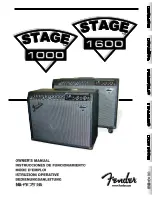
The Technical Stuff
_____________________________________________________________
19
At least one 610 module is still in use at Ocean Way Studios, site of the original United Recording
facility. Allen Sides, who purchased the studio from Putnam, personally traveled to Hawaii to collect
the 610 console that was used to record the live “Hawaii Calls” broadcasts. Celebrated engineer Jack
Joseph Puig has long been ensconced in Studio A at Ocean Way with the 610 (and a stunning
collection of vintage gear) where he has applied the vintage touch to many of today’s artists,
including Beck, Hole, Counting Crows, Goo Goo Dolls, No Doubt, Green Day and Jellyfish.
Today’s 6176 preamp section bears a lot of similarity to the original 610 module. The same 12AX7A
tube is used (along with a more modern 12AT7A), and the identical componentry values have been
maintained, along with many of the original unit’s features. Modern updates include a higher-quality
power supply, polypropylene caps, metal film resistors, custom-wound I/O transformers with double-
sized alloy cores, and newly added features such as high-impedance inputs, an enhanced EQ section,
and phantom power, switchable polarity inversion, and a switchable -15 dB pad on the mic inputs.
Limiter / Compressor section
The limiter / compressor
section of the 6176 is based upon the 1176LN, a device first released forty
years ago and still prized to this very day by audio professionals the world over. Designed by Bill
Putnam Sr., original founder of Universal Audio, its circuit evolved from the popular 175 and 176
vacuum tube limiters, combined with the latest solid-state amplification circuitry derived from the
company's successful 1108 preamplifier (also designed by Putnam). As is evident from entries and
schematics in his design notebook, Putnam experimented extensively at the time with the then newly
developed Field Effect Transistor (F.E.T.) in various configurations and eventually found a way of
using it as the gain-controlling element of a compressor.
The original version of the 1176, released in 1967, was denoted the 1176A, but was revised to the
model AB only a few months later, with improvements in stability and slightly reduced noise. The
following year saw revision B, with further minor changes to the preamplifier circuit. These models
all featured a brushed aluminum faceplate with a blue meter section.
1176 Revision B
Revision C, released in September 1970, saw two major changes. One, the unit now sported a black
faceplate instead of silver, and, two, it was now designated an 1176LN, with the “LN” standing for
“low noise.” This model featured first major modification to the 1176 circuit, designed by Brad
Plunkett in an effort to reduce noise, hence the birth of the 1176LN.
















































